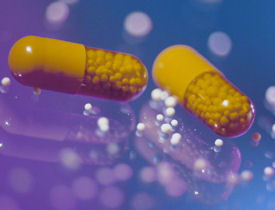Start with bloodwork to diagnose anemia
Anemia is fairly common, but its many etiologies complicate diagnosis. It affects more than one in five black and Hispanic people, one in 10 seniors and one in five of those over the age of 85. Learn how to fine-tune the diagnosis to best help patients.
Anemia in all its guises is fairly common in American adults and is becoming more so in some populations. Its many etiologies complicate diagnosis, yet accurately recognizing symptoms can help. Fatigue? Yes. Odd cravings? Sure. But a patient's pallor? Not really.
Data from the National Health and Nutrition Examination Survey (NHANES) and NHANES III suggest that anemia affects 2% of men, 9% to 12% of non-Hispanic white women, up to 22% of African-American and Mexican-American women, and 10% of seniors over age 65. Advancing age increases the risk of developing iron deficiency anemia. As many as 20% to 25% of seniors over age 85 are afflicted, so primary care physicians are likely to encounter iron deficiency anemia more frequently in their patients as they age.

Yet diagnosis requires some fine-tuning, said Philip Masters, MD, FACP, senior medical associate for content development for ACP and author of the Physicians' Information and Education Resource (PIER) module on microcytic anemia. “Part of the problem is that there is a debate about the numbers, so even defining anemia can be tricky,” he said.
For example, the Centers for Disease Control and Prevention defines anemia in women during the second trimester of pregnancy as a hemoglobin value of 10.5 g/dL, while the World Health Organization (WHO) uses a threshold of less than 11 g/dL for the same population. The National Kidney Foundation defines anemia in chronic kidney disease (CKD) as a hemoglobin level of less than 12 g/dL for women but less than 13.5 g/dL for men, only slightly higher than the WHO's cutoff for healthy men (13 g/dL).
It doesn't help that otherwise healthy patients are often asymptomatic because of the way the body can adapt to anemia, Dr. Masters added. “The blood will release more oxygen to the tissues, and cardiac output increases so that blood passes through the heart and gets to tissues to deliver oxygen more quickly,” he said. “I've had young, otherwise healthy women come in with hemoglobin values of 4 or 5 g/dL and their only complaint was that they were feeling a little bit tired.”
Ronald N. Rubin, MD, who wrote ACP's PIER module on macrocytic anemia, agreed. “It's uncommon for anemia itself to cause symptoms until the hemoglobin goes well below 10 g/dL,” said Dr. Rubin, who is a professor of medicine in the section of hematology at Temple University and associate professor at the Sol Sherry Thrombosis Research Center in Philadelphia. “About 90% of anemias are discovered by routine blood counts after the patient comes in for a checkup or has an appointment for another illness like a cough.”
What symptoms patients do have can be vague: Fatigue is the primary complaint, followed by headache and shortness of breath, dizziness, unusually rapid heartbeat, leg cramps and insomnia.
“When a patient complains of fatigue, try to tease that out by asking whether the person feels fatigue with exertion,” said ACP Member Casey O’Connell, MD, assistant professor of clinical medicine in the department of hematology at the University of Southern California in Los Angeles. “Remember that ‘fatigue’ could be the patient's term for shortness of breath.”
She noted other, more unusual symptoms that patients may not necessarily mention on their own. “If you suspect anemia, ask about changes in appetite and cravings. Pica, or the desire to chew on ice, is often overlooked, as are odd cravings for things like raw potatoes and clay. I had one patient who craved burned tortillas,” she said.
Internists may note other signs of anemia upon examining the patient, such as cracked lips or sores in the mouth or on the tongue. Pallor is not a particularly reliable sign, said Dr. Masters.
Importance of bloodwork
Experts agree that bloodwork, particularly blood counts and sizing, can not only indicate the type of anemia—macrocytic, microcytic, or normocytic and their subcategories—but suggest the cause, as well.
Dr. Masters said there are two basic approaches to assessing anemia via bloodwork. The first involves looking at the red blood cells and evaluating the mean corpuscular volume (MCV), or the average volume of red blood cells in a blood sample.
“Below 80 fL indicates microcytic anemias, 80 to 100 fL indicates normocytic anemias, and higher than 100 fL indicates macrocytic anemias. Each of these three will have differential diagnoses,” he said.
The experts note that in general, anemia associated with iron deficiency or thalassemia tends to be microcytic; anemia caused by blood loss, chronic disease, or inflammatory processes tends to be normocytic; and anemia stemming from deficiencies in vitamin B12 or folate or from primary bone marrow abnormalities tends to be macrocytic. However, these categories are not always mutually exclusive.
The second approach to evaluating bloodwork is to consider the possible dynamics of the anemia. “It's going to be one of three things: The body is not making enough red blood cells, the body is destroying too many red blood cells too quickly, or there's bleeding,” said Dr. Masters. “Performing a careful history and physical examination is critical in identifying medical conditions associated with decreased red blood cell production, hemolysis or bleeding. When coupled with evaluation of the other parts of the blood and additional selected laboratory tests, the likely cause of the anemia usually becomes apparent.”
Maureen Okam, MD, MPH, associate physician at Brigham and Women's Hospital, associate director of Brigham and Women's Hospital Infusion Center, and an instructor in medicine at Harvard Medical School in Boston, emphasizes the importance of looking at the volume of reticulocytes.
“If there is a problem with production in the bone marrow, reticulocyte counts will be low,” she said. “But if there is nothing wrong with the bone marrow, the count will go up as the body tries to compensate for the anemia.”
Process of elimination comes into play, said Dr. Masters. “If there's not a production problem, and there's no premature destruction of red blood cells, the patient is losing blood somewhere,” he said.
Risk and determining cause
Iron deficiency anemia is the most common form of anemia, and primary care physicians will most likely encounter it in menstruating women and the elderly, said Richard S. Eisenstaedt< MD, FACP, clinical professor of medicine at Temple University School of Medicine in Philadelphia and chair of the department of medicine at Abington Memorial Hospital in Abington, Pa.
“In menstruating women, it's almost always related to uterine blood loss, but it tends not to be severe and there usually aren't any dramatic negative outcomes,” he said.
Although there are some parallels between the elderly and younger patient populations in terms of B12 and folate deficiencies, iron deficiency in the elderly is a different story, Dr. Eisenstaedt said.
“In this population, iron deficiency anemia is most often due to gastrointestinal blood loss from ulcers, gastritis or colon cancer,” he said. “In fact, iron deficiency anemia in the elderly can be a way to discover colon cancer at an early stage.”
Patients with CKD also have elevated risk of developing anemia. According to a study published in the Oct. 15, 2004 Blood by Dr. Eisenstaedt and his colleagues, anemia affects 28% of patients with mild CKD and 87% of patients with severe CKD. “The main issue with chronic kidney disease is that it leads to a deficiency of erythropoietin,” said Dr. Eisenstaedt.
As diabetes is the leading cause of CKD—according to the American Diabetes Association, it accounts for 44% of new cases each year—people with diabetes are at higher risk for developing anemia, as well.
“Sometimes anemia will predate a rise in creatinine and may be an early manifestation of diabetic nephropathy,” said Dr. O’Connell. “Erythropoietin secretion drops before creatinine goes up. There's a kind of hyperfiltration stage to renal insufficiency.”
Dr. O’Connell notes that patients with chronic inflammatory diseases like rheumatoid arthritis and inflammatory bowel disease are at higher risk and suggests screening them more frequently than healthy patients. Statistics compiled by the National Anemia Action Council suggest that 30% to 60% of patients with rheumatoid arthritis have anemia, and a study in the August 2004 Gut notes that anemia affects roughly a third of patients with inflammatory bowel disease.
Patients with cancer are at high risk for developing anemia, especially if they undergo chemotherapy. A study published by the European Cancer Anaemia Survey in the March 2006 Oncology noted that roughly 83% of patients who received chemotherapy developed anemia.
Patients with chronic heart failure are also at risk, although studies note widely differing degrees. A paper published in the May 23, 2006 Circulation noted that estimates of anemia prevalence in this population range from 4% to 61%.
Treatment
Treatment of anemia depends on both the type of anemia and the cause, said Dr. Eisenstaedt. “For example, if it's bleeding from a GI condition, treat the GI condition and stop the bleeding. If it's erythropoietin deficiency from chronic kidney disease, treat with erythropoietin.”
He cautioned against automatically turning to iron supplements in patients who exhibit iron deficiency anemia, however. “Be sure the patient does not have thalassemia, because giving these patients iron could result in iron overload.”
The ACP PIER module on microcytic anemia suggests treating with 325 mg of ferrous sulfate three times per day after the cause is identified and corrected, likewise if the iron deficiency anemia is associated with menstruation. However, there's a caveat, said Dr. Eisenstaedt. “Starting at that dose may lead to unpleasant GI symptoms, especially constipation, so you might want to start the patient at a lower dose and gradually build up to it.”
Patients who have bowel disease or who have had a gastric bypass won't absorb iron from oral supplements, said Dr. Masters. He added that antacids may interfere with iron absorption in the stomach.
In B12 insufficiency, Dr. Eisenstaedt noted that shots may not be necessary. “If the patient has pernicious anemia and does not absorb B12 efficiently, oral B12 may work just as well if the dose is high enough to compensate for the malabsorption.”
Some patients may choose to take complementary therapies such as spirulina, alfalfa or gentian, but there is not a lot of evidence to suggest that they are effective, said Dr. Okam. “They're unlikely to get in the way of treatment, so we don't necessarily discourage them, but we just don't know much about them.”
Importantly, spirulina contains pseudovitamin B12 which is biologically inactive in humans and is therefore not a reliable source of vitamin B12, a point Dr. Okam tries to convey to patients.
Dr. Rubin agreed. “The FDA makes [the manufacturers] use words like ‘for support of blood health.’ I'm not sure what that means. They're not specific.”
He added that some supplements may make it tough to detect bleeding, especially if they are high in iron. “That can actually cover up the bleeding [by overcompensating for lost iron].”
Dr. Eisenstaedt noted the potential for interactions. “The more things you take, the more likely you are to have an interaction, so I urge patients not to go overboard.”
When to refer
Straightforward diagnoses such as iron deficiency anemia in menstruating women are relatively easy for internists to treat, said Dr. Masters.
“But from a hematologic perspective, if you have done a reasonable workup and still can't explain the cause, there are abnormalities that suggest a bone marrow problem, there are drops in all three cell lines, or the white blood cell counts are exceedingly low or high, it's time to refer the patient to a hematologist,” Dr. Masters said.
Likewise, he said, refer the patient if the anemia can be attributed to chronic diseases normally treated by specialists, such as CKD, rheumatoid arthritis, cancer or gastrointestinal disease.
The experts agree that a gastrointestinal workup should be a matter of course for elderly patients and postmenopausal women with signs of iron deficiency anemia. “Make that referral right away,” said Dr. O’Connell. “It shouldn't be delayed while you wait for an evaluation by a hematologist.”
Finally, internists should refer when the patient doesn't respond to treatment, when the diagnosis isn't clear, or when the blood analysis suggests hemolysis, said Dr. Rubin.
“I believe very strongly that if the internist looks at the Coulter report [blood analysis], that can take a third of the cases off the table,” he said. “When an internist orders an analysis and then refers a patient to me, the internist has already done me a world of good.”





